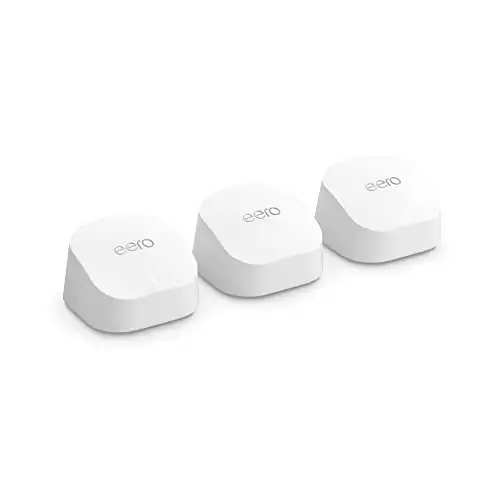A Connected Home, Simplified: Mesh Network Solutions on Amazon

Upgrade Your Internet Wifi with Mesh Wi-Fi Systems
In recent years, mesh Wi-Fi systems have emerged as a pivotal solution for achieving robust and seamless wireless connectivity in modern homes. These systems utilize multiple devices, or nodes, to create a unified network, allowing for broader coverage and improved internet speeds across various areas of a household. This configuration is particularly essential in the context of today’s digital landscape, where the proliferation of smart home devices, remote working arrangements, and high-definition streaming services has increased the demand for reliable and high-speed internet access.
The need for stable internet connections has grown significantly as households become more connected than ever. Smart devices, such as security cameras, smart speakers, and home automation systems, require a consistent and high-performing network to function optimally. Moreover, the rise of telecommuting and online collaboration tools has placed further strain on traditional Wi-Fi setups, emphasizing the importance of investing in a comprehensive network solution. Mesh Wi-Fi systems effectively address these challenges by minimizing dead zones and optimizing signal strength throughout the home.
In this blog post, we will compare three prominent mesh Wi-Fi systems: the TP-Link Deco AX3000, Amazon Eero 6, and Google Wi-Fi AC1200. Each of these models offers unique features and specifications that cater to different user needs, from performance and ease of setup to coverage area and device capacity. Understanding the distinctions among these systems will enable consumers to make informed decisions when selecting a suitable mesh Wi-Fi solution for their home, ultimately enhancing their online experience and connectivity reliability in a world that increasingly relies on robust internet access.
Overview of TP-Link Deco AX3000
TP-Link Deco AX3000 WiFi 6 Mesh System(Deco X55)
The TP-Link Deco AX3000 is a robust Wi-Fi 6 mesh system designed to deliver high-performance connectivity throughout your home or office. With a dual-band structure, it can achieve combined speeds of up to 3 Gbps, which is ideal for gaming, streaming, and browsing. The system covers an expansive area of up to 2,700 square feet with just two units, ensuring ample coverage for larger spaces while supporting multiple devices simultaneously without sacrificing speed.
One of the standout features of the Deco AX3000 is its user-friendly app, which simplifies the installation process. Users can set up the system in minutes, guiding them step-by-step through the configuration via their smartphones. The app also offers advanced features such as network management, device prioritization, and basic troubleshooting, making it accessible even for those with limited technical knowledge.
Security is a top priority for the Deco AX3000, which includes TP-Link’s HomeCare for comprehensive protection. This feature comprises robust antivirus capabilities, parental controls, and Quality of Service (QoS) options, allowing users to manage internet access for family members and prioritize bandwidth for specific applications or devices seamlessly. Moreover, the system automatically updates its firmware to provide the latest security improvements, thus keeping the network safe from evolving threats.
User experiences highlight the Deco AX3000’s reliability and performance consistency. Many reviews praise its ability to maintain stable connections across multiple rooms, eliminating dead zones that are common in traditional routers. Overall, the TP-Link Deco AX3000 presents an appealing option for users seeking a combination of speed, security, and ease of use, making it a strong contender in the current mesh Wi-Fi market.
Exploring Amazon Eero 6 Mesh Wi-Fi System
Amazon eero 6 mesh Wi-Fi system
The Amazon Eero 6 Mesh Wi-Fi System has garnered attention for its user-friendly setup and effective performance metrics. This state-of-the-art system operates on the Wi-Fi 6 standard, providing not only enhanced speed but also improved efficiency in handling multiple connected devices simultaneously. It supports a maximum speed of up to 900 Mbps, making it an optimal choice for households that rely heavily on smart devices, streaming services, and online gaming.
One of the standout features of the Eero 6 system is its seamless integration with Amazon Alexa, allowing users to manage their network through simple voice commands. This level of convenience further emphasizes its appeal, especially to tech-savvy users who prioritize smart home solutions. Furthermore, setting up the Eero 6 is a straightforward process. Users can utilize the Eero app, which guides them through each step, from installation to network management, making it accessible even for individuals with limited technical expertise.
Performance-wise, the Amazon Eero 6 excels in providing robust coverage. The system’s mesh network capabilities ensure that Wi-Fi signals are evenly distributed throughout the home, minimizing dead spots. According to user testimonials, many have reported significant improvements in both speed and reliability compared to their previous routers, allowing for smooth downloads, uninterrupted streaming, and stable connections across a variety of devices.
Overall, the Eero 6 Mesh Wi-Fi System distinguishes itself through its compatibility, ease of use, and effective performance. With its efficient coverage spanning up to 1,500 square feet per unit, it caters well to medium-sized homes. Users appreciate the combination of speed and reliability that the system offers, making it a noteworthy contender in the competitive mesh Wi-Fi market.
Google Wi-Fi AC1200 Mesh System: A Deep Dive
Google Wifi – AC1200 – Mesh WiFi System
The Google Wi-Fi AC1200 Mesh System is a prime example of modern networking technology, designed to provide seamless internet connectivity throughout homes and small offices. The system boasts an AC1200 rating, suggesting it can deliver combined speed levels of up to 1.2 Gbps across its dual-band frequencies. Each unit is equipped with multiple gigabit Ethernet ports, facilitating wired connections to laptops, gaming consoles, or other high-bandwidth devices. The ability to expand coverage by adding additional Google Wi-Fi units distinguishes it as a versatile choice for larger spaces or areas with challenging layouts.
One of the most significant advantages of the Google Wi-Fi system is its user-friendly setup process, which is often highlighted by consumers. Using the Google Home app, users can configure their network in a matter of minutes. This ease of use is further complemented by features such as Network Assist, which automatically optimizes performance by selecting the best band for connected devices while minimizing interruptions.
In terms of smart home integration, the Google Wi-Fi AC1200 functions seamlessly with Google Home and other Google Assistant-compatible devices. This compatibility allows users to manage their internet settings using voice commands, enhancing the product’s appeal and convenience. Additionally, built-in parental controls enable users to monitor and manage children’s internet access, a feature that has garnered positive feedback from parents who value online safety.
Coverage and speeds are often praised by customers, as the mesh design of the Google Wi-Fi allows for a more reliable connection in every corner of a home. With a range of up to 1,500 square feet per unit, users have reported improved connectivity, even in larger spaces with obstacles. Overall, the Google Wi-Fi AC1200 Mesh System stands out for its user-friendliness, innovative features, and strong performance, making it a formidable contender in the mesh Wi-Fi market.

